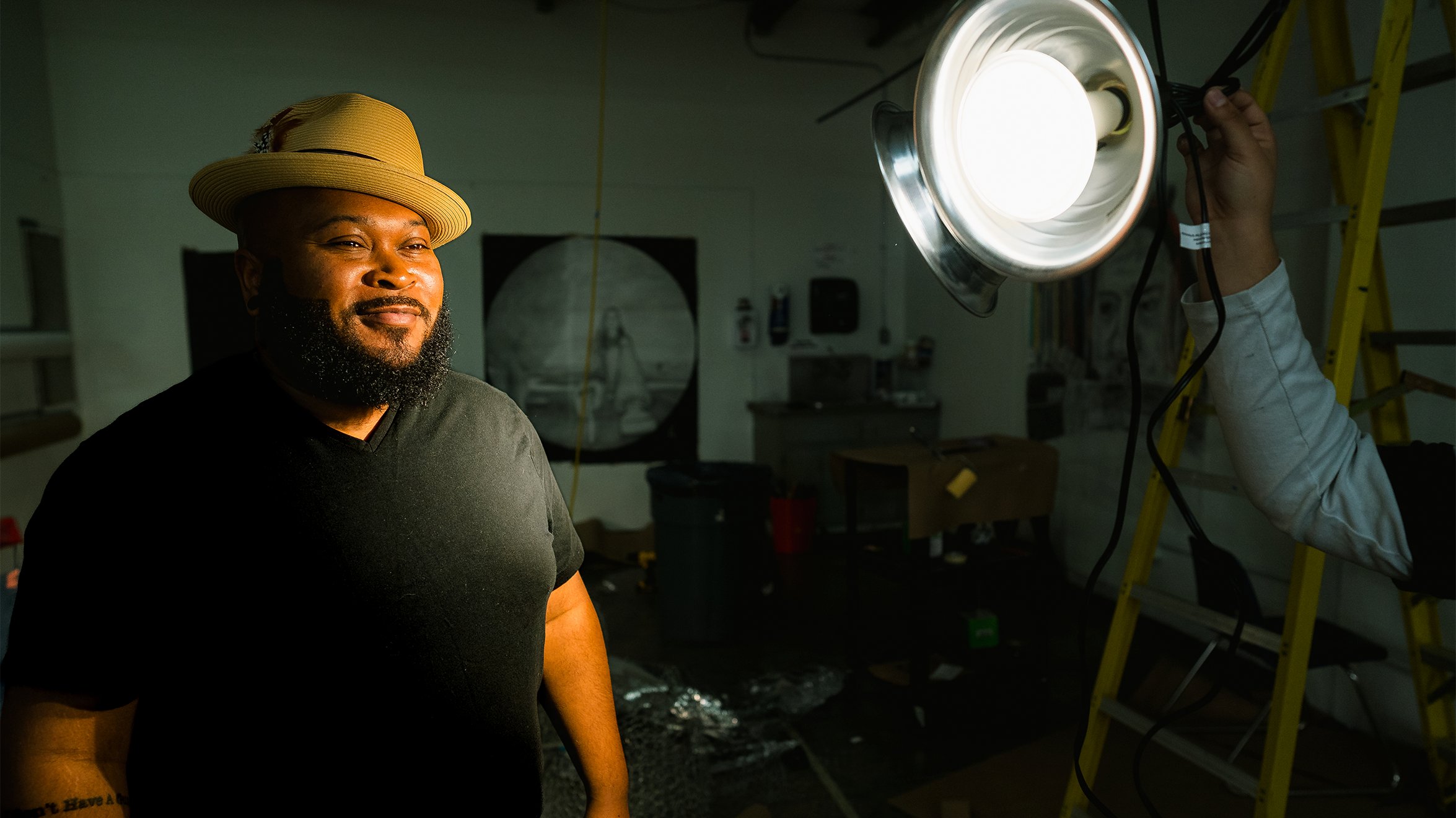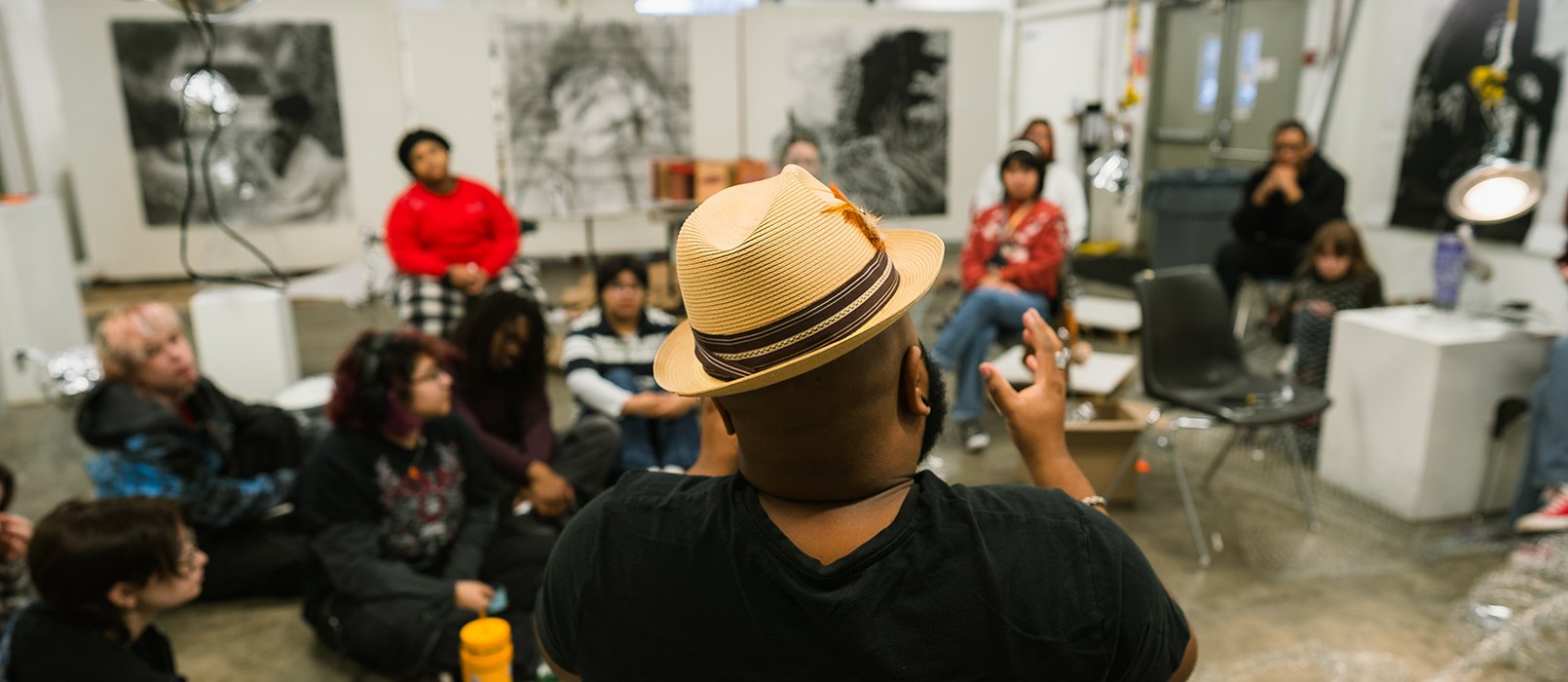
Sculpture from Kevin Demery’s “A Lesson Before Dying” Enters Nelson-Atkins Collection
11.24.2025
Kevin Demery’s work was featured in the 2024 Charlotte Street Visual Artist Awards Exhibition at the Nelson-Atkins Museum of Art, just across the street from the Kansas City Art Institute.
The Kansas City Art Institute is proud to share that the Nelson-Atkins Museum of Art has acquired a sculpture from Kevin Demery’s exhibition A Lesson Before Dying. Demery, Assistant Professor of Foundation, created the series of wind chimes for the 2024 Charlotte Street Visual Artist Awards Exhibition, developing the work after a moment of inspiration while reading in his studio.
In Fall 2024, Demery shared the concept behind the work with a group of his students during a visit to the exhibition:
“And there was this image of this young person in this book that was a mugshot. These wind chimes here are the silhouette of the youngest person ever executed in the United States. He was 14 years old. His name was George Stinney Jr. And in the year 1944, which was so long ago, right? But at the same time not so long ago, he was actually falsely accused of murder. And then he was taken to the electric chair.
And I started routing out and cutting the silhouette of their mugshot. So it’s the side profile of them. And I kept thinking about the idea of what it means to be profiled, for someone to flatten your identity, right?
When I was walking, I started hearing a lot of the same repetitive sounds. Every time I would walk in this neighborhood I would hear a wind chime and I would go, ‘Oh, there’s a wind chime here,’ but I didn’t have to see it. And I remember thinking that when you can understand something without having to see it, that’s a beautiful metaphor for a lot of things that we feel every day.
So I’ve always been somebody who doesn’t run away from tragedy. It’s something that has been in my life quite a bit in a lot of different ways. Making artwork for me is how I process these very difficult things because I always try to be a very positive person because I always try to be a very positive person. And I think that in some ways that means confronting those things.”
One of the pieces was later purchased by Major Dwight Oran Smith (U.S. Army Retired), who then gifted the sculpture to the Nelson-Atkins Museum of Art. In a letter of thanks to Smith, Museum Director & CEO Julián Zugazagoitia wrote, “A driving force in Demery's practice and work like A Lesson Before Dying and the sculptures in the series, is the exploration of how Black historical narratives serve as a haunting voice or specter—an effect amplified through his thoughtful incorporation of shadows, subtle movement, and sound.”
Zugazagoitia continued in his letter: “The addition of A Lesson Before Dying to the museum's global, encyclopedic collection will assist visitors to better understand our collective history—both distant and more recent—while equipping them to navigate the future with more open eyes, minds, and hearts.”
The letter continues: “As the Nelson-Atkins aims to tell a richer story of human experiences through the acquisition of art made by artists historically excluded from the canon, your gift will provide opportunities for visitors to both see themselves reflected in the collection and build empathy for a range of experiences through direct experience with art.”

"I’m drawn to the use of unconventional materials to reveal the subtle nuances of the histories I awaken."
Object Poetry
Kevin Demery is an interdisciplinary artist from the San Francisco Bay Area whose work has been exhibited internationally. His practice seeks out the poetry within objects as a way to interrogate Black historical narratives and explore the sociopolitical realities he encounters as a Black man.
A Lesson Before Dying addresses themes that Demery describes as having “permeated African American communities from emancipation to present day.”
“Sculpture is the vehicle I use to engage the audience with iconic elements such as children’s puzzles, windchimes, and plaster-cast hands,” he notes. “Many of the works reference specific histories and poetically interpret them within larger cultural experiences.”
“I’m drawn to the use of unconventional materials to reveal the subtle nuances of the histories I awaken. In this, I find links between the objects I create and my experience growing up as an African American youth amid atmospheres riddled with political inertia, poverty, and violence,” Demery said.